

This master is named for an early panel of St Francis that was then in the sacristy of Santa Maria degli Angeli, Assisi. The German art historian, Henry Thode first associated him with:
-
✴the frescoes in the nave of the Lower Church of San Francesco, Assisi; and
-
✴two works in San Francesco al Prato, Perugia:
-
•some panels from a polyptych; and
-
•a Crucifix dated 1272.
Some of the stained glass in the Upper Church of San Francesco, Assisi have subsequently been attributed to this master. These works are described below.
Assisi
St Francis (ca. 1255)
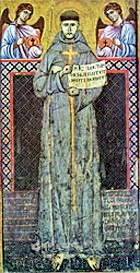
-
✴The Latin inscription on the open book that St Francis holds translates: "This was my bed when I was living and when I was dying". This inspired the tradition that the wood used for this panel came from the board upon which St Francis died and upon which his body was laid as it was taken from the Portiuncula for burial in Assisi. However, the "bed" is probably a reference to the cross on which Christ died.
-
✴The long inscription in the lower part of the panel is taken from a Bull (1237) that Pope Gregory IX issued in defence of the authenticity of the stigmata.
Frescoes from the Lower Church of San Francesco (ca. 1260-5)


These frescoes originally flanked the narrow windows in the three bays on each side of the nave of the lower church. The dating of the work and its historical context are discussed in the page on San Francesco in the period 1253-1300. The frescoes were badly damaged in the early 14th century, when these windows were removed to make way for the entrances to new side chapels.
The scenes are arranged above in the order that you will see them if you walk clockwise around the nave, starting on the left at the end nearest the entrance narthex. They depict:
-
✴scenes from the life of St Francis, on the left wall (above in this illustration):
-
•St Francis renounces his worldly goods;
-
•the dream of Pope Innocent III, in which he sees St Francis propping up San Giovanni Laterano (a surrogate for the Church in general);
-
•St Francis preaches to the birds;
-
•St Francis receives the stigmata (of which only the seraph survives); and
-
•the death of Francis (in which the friars point to the wound in his side and, at the top right, his soul is carried to Heaven by angels); and
-
✴scenes from the passion of Christ, on the right:
-
•Christ prepares for execution;
-
•the Crucifixion (during which Christ commends his mother to the care of St John the Evangelist);
-
•the Deposition;
-
•the lamentation over the body of Christ, with the swooning Virgin to the left; and
-
•an almost unintelligible scene that has recently been recognised as the supper at Emmaus.
The positioning of these two cycles of scenes on opposite walls illustrates the Franciscan devotion to St Francis as “Alter Christus” (the other Christ). This is the earliest surviving extensive depiction of this theological position in art.
Stained Glass (ca. 1275)
A number of stained glass windows of the upper church of San Francesco, Assisi (those of the right transept and most of those in the nave) has been attributed to the Maestro di San Francesco. If this attribution is correct, then he was probably the earliest Italian artist to acquire this skill. The dating of the work and its historical context are discussed in the page on San Francesco in the period 1253-1300.
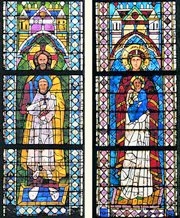
Perugia
Christus Patiens with St Francis (1272)
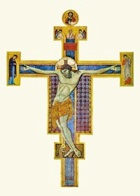
The Crucifix depicts the agony of the dying Christ:
-
✴The grieving Virgin and St John the Evangelist flank the outstretched arms of Christ;
-
✴a small half-length figure of the praying Virgin between angels terminates the vertical arm of the cross, with Christ the Redeemer in a tondo above; and
-
✴the stigmatised St Francis kneels at the foot of the cross, contemplating the wounds in the feet of Christ.
Processional Crucifix (ca. 1272)
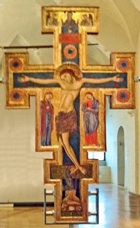
-
✴One side has an inscription HIC NAZARENUS; REX IUDEORUM; REX GL]ORIA]E in the upper panel, while the lower panel is blank.
-
✴On the other side (illustrated here), both panels are painted:
-
•the upper panel contains a small half-length figure of the praying Virgin between angels, above a smaller copy if the above inscription; and
-
•the lower panel contains a small kneeling figure of St Francis kissing the right foot of Christ. This figure was over-painted at some point to remove a small identifying inscription and the Franciscan habit, but these original features were revealed in a recent restoration. Each side depicts the suffering Christ on the cross, with the Virgin and St John the Evangelist to the sides. In addition, on one side, there is a small half-length figure of the praying Virgin between angels above the cross, and a small kneeling figure of St Francis kissing the right foot of Christ. The figure of St Francis was over-painted at some point to remove his attributes of the stigmata and the Franciscan cord, but these original features were revealed in a recent restoration.
Panels from a polyptych (ca. 1272)
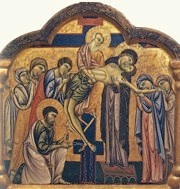

Deposition of Christ Lamentation
Ten widely dispersed panels (including the two illustrated above), which are attributed to the Maestro di San Francesco, were recognised in 1961 to have belonged to the earliest double-sided altarpiece of which we are aware. In 1982, Dillian Gordon (see below) demonstrated that these ten panels constituted less than half those that were originally mounted in a monumental frame. She suggested that the altarpiece had originally been on the high altar of San Francesco al Prato, Perugia. The altarpiece and the Crucifix illustrated above probably both belonged to the same prestigious commission. In 2001, Donal Cooper (see below) pointed out that the need for a double-sided altarpiece on the high altar probably arose because the friars had a choir behind it, despite the fact that such an arrangement was uncommon in similar churches in other parts of Italy until the 16th century.
Dillian Gordon reconstructed this remarkably wide polyptych as follows:
-
✴The panels facing the friars in the choir of the church would have been (from left to right):
-
•a saint and/or prophet, probably St Francis (lost);
-
•two scenes from the Passion (lost);
-
•a saint and/or prophet, probably the prophet Jeremiah (lost);
-
•a central scene, probably of the Crucifixion (lost);
-
•the prophet Isaiah (Museo del Tesoro di San Francesco, Assisi);
-
•the Deposition of Christ (Perugia, illustrated above);
-
•the Lamentation (Perugia, illustrated above); and
-
•St Antony of Padua (Perugia).
-
✴The panels facing the congregation in the nave would have been (from left to right):
-
•the stigmatised St Francis, whose Gospel is open at Galatians 2:19, “I have been crucified with Christ” (Perugia);
-
•SS Simon and Bartholomew (Metropolitan Museum, New York);
-
•St James Minor (National Gallery, Washington);
-
•St Andrew (only identified as such when a restoration in 1994 described him as the saint who evangelised “Patras”) (Perugia);
-
•a central scene, probably of the Madonna and Child (lost); and
-
•four other panels, including:
-
•St Peter (Perugia); and
-
•St John the Evangelist (National Gallery, Washington).
(In this list, “Perugia” indicates a panel that is now in the Galleria Nazionale, Perugia).
The polyptych was replaced in 1403 and subsequently dismembered. The panels, which were probably moved initially to the sacristy, were subsequently dispersed.
-
✴The three panels that are now in America and the panel of St Peter passed to the Arciconfraternita della Pietà del Camposanto Teutonico, Rome at some point and were on-sold in 1921.
-
✴The panel of Isaiah was discovered at San Francesco, Assisi in 1919.
-
✴All the panels that are now in the Galleria Nazionale, Perugia, except the panel of St Peter, were acquired from local collectors over the five decades up to 1932.
-
✴The panel of St Peter found its way to a private collection in Brussels and was acquired by the gallery in 2001.
Read more:
D. Gordon, “A Perugian Provenance for the Franciscan Double-sided Altarpiece by the Maestro di S. Francesco”, Burlington Magazine, 124 (1982) 70-7
E. Lunghi, “Il Crocefisso di Giunta Pisano e l' Icona del Maestro di San Francesco alla Porziuncola”, Assisi, (1995)
D. Cooper, “Franciscan Choir Enclosures and the Function of Altarpieces in pre-Tridentine Umbria”, Journal of the Warburg and Courtauld Institutes, 64 (2001) 1-54

